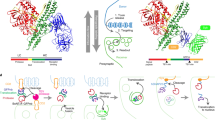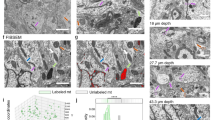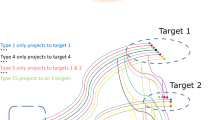Abstract
This protocol describes a double retrograde tracing method to chart divergent projections in the CNS using light microscope techniques. It is based on immunohistochemical visualization of retrograde transport of cholera toxin b-subunit (CTb) and silver enhancement of a gold–lectin conjugate. Production of the gold–lectin is explained in detail, and a technique is offered to record through the injection pipettes, to help guide accurate placement of injections. Visualization of the two tracers results in light brown staining of CTb-labeled neurons and labeling by black particles of gold–lectin-containing neurons. Both types of label are easily recognized in the same neuron. The labeling is permanent and is well suited for studies in which large areas of the brain need to be surveyed. The whole procedure (excluding survival time) takes approximately 5–7 d to complete.
This is a preview of subscription content, access via your institution
Access options
Subscribe to this journal
Receive 12 print issues and online access
$259.00 per year
only $21.58 per issue
Buy this article
- Purchase on Springer Link
- Instant access to full article PDF
Prices may be subject to local taxes which are calculated during checkout



Similar content being viewed by others
References
Apps, R. & Ruigrok, T.J.H. A fluorescence-based double retrograde tracer strategy for charting central neuronal connections. Nat. Protoc. 2, 1862–1868 (2007).
Luppi, P.-H., Fort, P. & Jouvet, M. Iontophoretic application of unconjugated cholera toxin B subunit (CTb) combined with immunohistochemistry of neurochemical substances: a method for transmitter identification of retrodradely labeled neurons. Brain Res. 534, 209–224 (1990).
Ruigrok, T.J.H., Teune, T.M., van der Burg, J. & Sabel-Goedknegt, H. A retrograde double labeling technique for light microscopy. A combination of axonal transport of cholera toxin B-subunit and a gold-lectin conjugate. J. Neurosci. Meth. 61, 127–138 (1995).
Roth, J. The colloidal gold marker system for light and electron microscopic cytochemistry. In Techniques in Immunocytochemistry Vol. 2 (eds. Bullock, G.R. & Petrusz, P.) 217–284 (Academic Press, London, 1983).
Gonatas, N.K., Harper, C., Mizutani, T. & Gonatas, J.O. Superior sensitivity of conjugates of horse radish peroxidase with wheat germ agglutinin for studies of retrograde axonal transport. J. Histochem. Cytochem. 27, 728–734 (1979).
Schwab, M.E., Javoy-Agid, F. & Agid, Y. Labeled wheat germ agglutinin (WGA) as a new, highly sensitive retrograde tracer in the rat brain hippocampal system. Brain Res. 152, 145–150 (1978).
Basbaum, A.I. & Menétrey, D. Wheat germ agglutinin-apoHRP gold: a new retrograde tracer for light- and electronmicroscopic single- and double-label studies. J. Comp. Neurol. 261, 306–318 (1987).
Ericson, H. & Blomqvist, A. Tracing of neuronal connections with cholera toxin subunit B: light and electron microscopic immunohistochemistry using monoclonal antibodies. J. Neurosci. Methods 24, 225–235 (1988).
Chen, S. & Ashton-Jones, G. Evidence that cholera toxin B subunit (CTb) can be avidly taken up and transported by fibers of passage. Brain Res. 674, 107–111 (1995).
Geoghegan, W.D. & Ackerman, G.A. Adsorption of horseradish peroxidase, ovomucoid and anti-immunoglobulin to colloidal gold for the indirect detection of concanavalin A, wheat germ agglutinin and goat anti-human immunoglobulin G on cell surfaces at the electron microscopic level: a new method, theory and application. J. Histochem. Cytochem. 25, 1187–1200 (1977).
Flecknell, P.A. Laboratory Animal Anaesthesia (Academic Press, London, 1987).
Paxinos, G. & Watson, C. The Rat Brain in Stereotaxic Coordinates (Academic Press, San Diego, 1998).
Paxinos, G. & Franklin, K.B.J. The Mouse Brain in Stereotaxic Coordinates (Academic Press, San Diego, 2001).
Luppi, P.-H., Aston-Jones, G., Akaoka, H., Chouvet, G. & Jouvet, M. Afferent projections to the rat locus coeruleus demonstrated by retrograde and anterograde tracing with cholera-toxin B subunit and Phaseolus vulgaris leucoagglutinin. Neuroscience 65, 119–160 (1995).
Pijpers, A. & Ruigrok, T.J. Organization of pontocerebellar projections to identified climbing fiber zones in the rat. J. Comp. Neurol. 496, 513–528 (2006).
Voogd, J., Pardoe, J., Ruigrok, T.J. & Apps, R. The distribution of climbing and mossy fiber collateral branches from the copula pyramidis and the paramedian lobule: congruence of climbing fiber cortical zones and the pattern of zebrin banding within the rat cerebellum. J. Neurosci. 23, 4645–4656 (2003).
Menétrey, D. Retrograde tracing of neural pathways with a protein-gold complex. I. Light microscopic detection after silver intensification. Histochemistry 83, 391–395 (1985).
Koekkoek, S.K.E. & Ruigrok, T.J.H. Lack of bilateral projection of individual spinal neurons to the lateral reticular nucleus in the rat: a retrograde, non-fluorescent, double labeling study. Neurosci. Lett. 200, 13–16 (1995).
Wentzel, P.R., Wylie, D.R., Ruigrok, T.J.H. & De Zeeuw, C.I. Olivary projecting neurons in the nucleus prepositus hypoglossi, group y and ventral dentate nucleus do not project to the oculomotor complex in the rabbit and the rat. Neurosci. Lett. 190, 45–48 (1995).
Chen, S. & Aston-Jones, G. Axonal collateral-collateral transport of tract tracers in brain neurons: false anterograde labelling and useful tool. Neuroscience 82, 1151–1163 (1998).
Pijpers, A., Apps, R., Pardoe, J., Voogd, J. & Ruigrok, T.J. Precise spatial relationships between mossy fibers and climbing fibers in rat cerebellar cortical zones. J. Neurosci. 26, 12067–12080 (2006).
Menétrey, D. & Lee, C.L. Retrograde tracing of neural pathways with a protein gold complex. II. Electron microscopic demonstration of projections and collaterals. Histochemistry 83, 525–530 (1985).
Teune, T.M., van der Burg, J., De Zeeuw, C.I., Voogd, J. & Ruigrok, T.J.H. Single Purkinje cell can innervate multiple classes of projection neurons in the cerebellar nuclei of the rat: a light microscopic and ultrastructural triple-tracer study in the rat. J. Comp. Neurol. 392, 164–178 (1998).
Jaarsma, D. et al. Cholinergic innervation and receptors in the cerebellum. In The cerebellum: From structure to control Vol. 114 (eds. De Zeeuw, C.I., Strata, P. & Voogd, J.) 67–96 (Elsevier, Amsterdam, 1997).
Toonen, M. et al. Light microscopic and ultrastructural investigation of the dopaminergic innervation of the ventrolateral outgrowth of the rat inferior olive. Brain Res. 802, 267–273 (1998).
Pijpers, A., Voogd, J. & Ruigrok, T.J. Topography of olivo-cortico-nuclear modules in the intermediate cerebellum of the rat. J. Comput. Neurol. 492, 193–213 (2005).
Leman, S., Viltart, O. & Sequeira, H. Double immunocytochemistry for the detection of Fos protein in retrogradely identified neurons using cholera toxin B subunit. Brain Res. Brain Res. Protoc. 5, 298–304 (2000).
Oldenbeuving, A.W., Eisenman, L.M., De Zeeuw, C.I. & Ruigrok, T.H. Inferior olivary-induced expression of Fos-like immunoreactivity in the cerebellar nuclei of wild-type and Lurcher mice. Eur. J. Neurosci. 11, 3809–3822 (1999).
Jongen-Relo, A.L. & Amaral, D.G. Evidence for a GABAergic projection from the central nucleus of the amygdala to the brainstem of the macaque monkey: a combined retrograde tracing and in situ hybridization study. Eur. J. Neurosci. 10, 2924–2933 (1998).
Atkins, M.J. & Apps, R. Somatotopical organisation within the climbing fibre projection to the paramedian lobule and copula pyramidis of the rat cerebellum. J. Comput. Neurol. 389, 249–263 (1997).
Apps, R. & Garwicz, M. Precise matching of olivo-cortical divergence and cortico-nuclear convergence between somatotopically corresponding areas in the medial C1 and medial C3 zones of the paravermal cerebellum. Europ. J. Neurosci. 12, 205–214 (2000).
King, V.M., Armstrong, D.M., Apps, R. & Trott, J.R. Numerical aspects of pontine, lateral reticular, and inferior olivary projections to two paravermal cortical zones of the cat cerebellum. J. Comput. Neurol. 390, 537–551 (1998).
Acknowledgements
The authors gratefully acknowledge the supreme technical expertise of Hans van der Burg and Erika Sabel-Goedknegt in the development of this protocol. This work was supported by grants from the Biotechnology and Biological Sciences Research Council (BBSRC) and the Wellcome Trust (to R.A.), and by the Netherlands Organisation for Scientific Research, Division of Earth and Life Sciences and the Dutch Ministry of Health, Welfare, and Sports (to T.J.H.R.).
Author information
Authors and Affiliations
Corresponding author
Ethics declarations
Competing interests
The authors declare no competing financial interests.
Rights and permissions
About this article
Cite this article
Ruigrok, T., Apps, R. A light microscope-based double retrograde tracer strategy to chart central neuronal connections. Nat Protoc 2, 1869–1878 (2007). https://doi.org/10.1038/nprot.2007.264
Published:
Issue Date:
DOI: https://doi.org/10.1038/nprot.2007.264
This article is cited by
-
Neuroanatomical tract-tracing techniques that did go viral
Brain Structure and Function (2020)
-
Preparation and implementation of optofluidic neural probes for in vivo wireless pharmacology and optogenetics
Nature Protocols (2017)
-
Differential Changes in the Peptidergic and the Non-Peptidergic Skin Innervation in Rat Models for Inflammation, Dry Skin Itch, and Dermatitis
Journal of Investigative Dermatology (2015)
-
Spatiotemporal Dynamics of Re-Innervation and Hyperinnervation Patterns by Uninjured CGRP Fibers in the Rat Foot Sole Epidermis after Nerve Injury
Molecular Pain (2012)
-
Ins and Outs of Cerebellar Modules
The Cerebellum (2011)
Comments
By submitting a comment you agree to abide by our Terms and Community Guidelines. If you find something abusive or that does not comply with our terms or guidelines please flag it as inappropriate.



